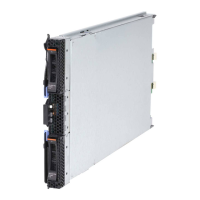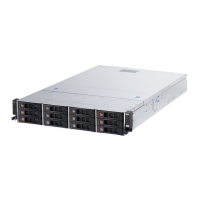server, or visit the IBM
®
Director Information Center at http://
publib.boulder.ibm.com/infocenter/director/v6r1x/index.jsp.
Information LED: When this amber LED is lit, it indicates that information about a
system event in the blade server has been placed in the Advanced-Management-
Module event log. The information LED can be turned off through the
Advanced-Management-Module CLI, SNMP, or Web interface or through IBM
®
Director Console. For more information about the Advanced-Management-Module
Web interface, see http://www.ibm.com/systems/management/. For more
information about IBM
®
Director, see the documentation on the IBM
®
Director CD
that comes with the server, or visit the IBM
®
Director Information Center at
http://publib.boulder.ibm.com/infocenter/director/v6r1x/index.jsp.
Fault LED: When this amber LED is lit, it indicates that a system error has
occurred in the blade server. The blade-error LED turns off only after the error is
corrected.
Power-control button: Press this button to turn on or turn off the blade server.
Note: The power-control button has effect only if local power control is enabled
for the blade server. Local power control is enabled and disabled through the
Advanced-Management-Module Web interface.
Keyboard/video/mouse (KVM) select button: Press this button to associate the
shared BladeCenter unit keyboard port, video port, and mouse port with the blade
server. The LED on this button flashes while the request is being processed and
then is lit when the ownership of the keyboard, video, and mouse has been
transferred to the blade server. It can take approximately 20 seconds to switch the
keyboard, video, and mouse control to the blade server.
Using a keyboard that is directly attached to the Advanced-Management-Module,
you can press keyboard keys in the following sequence to switch KVM control
between blade servers instead of using the KVM select button:
NumLock NumLock blade_server_number Enter
blade_server_number is the two-digit number of the blade-server bay in which
the blade server is installed. A blade server that occupies more than one
blade-server bay is identified by the lowest bay number that it occupies.
If there is no response when you press the KVM select button, you can use the
Advanced-Management-Module Web interface to determine whether local control
has been disabled on the blade server. See http://www.ibm.com/systems/
management/ for more information.
Notes:
1. The operating system in the blade server must provide USB support for the
blade server to recognize and use the keyboard and mouse, even if the
keyboard and mouse have PS/2-style connectors.
2. If you install a supported Microsoft Windows operating system on the blade
server while it is not the current owner of the keyboard, video, and mouse, a
delay of up to 1 minute occurs the first time that you switch the keyboard,
video, and mouse to the blade server. All subsequent switching takes place in
the normal KVM switching time frame (up to 20 seconds).
Media-tray select button: Press this button to associate the shared BladeCenter
unit media tray (removable-media drives) with the blade server. The LED on the
16 BladeCenter HS22 Type 7870 and 1936: Installation and User's Guide

